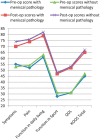A Retrospective Study Assessing Safety and Efficacy of Bipolar Radiofrequency Ablation for Knee Chondral Lesions
- PMID: 28425303
- PMCID: PMC6042031
- DOI: 10.1177/1947603517703731
A Retrospective Study Assessing Safety and Efficacy of Bipolar Radiofrequency Ablation for Knee Chondral Lesions
Abstract
Objective: Bipolar radiofrequency (bRF) ablation is gaining popularity as a treatment modality for unstable knee chondral lesions of the knee. Limited reports of osteonecrosis and chondrolysis have been published; however, there is little data examining the safety of this treatment in larger series. This study aims to evaluate the safety and efficacy of bRF in the treatment of chondral lesions encountered during knee arthroscopy.
Design: A retrospective evaluation of adverse outcomes in patients that underwent treatment of chondral lesions using bRF was undertaken. Secondary outcome measures included change in patient reported outcome scores and its correlation to patient demographics and quality of chondral and meniscal lesions using Chondropenia Severity Score.
Results: Only 2.2% and 2.7% of the patients had a postoperative complication or required a reoperation, respectively. None of the complications were directly related to the use of bRF. A statistically significant difference was observed when comparing pre- and postoperative scores in all normalized categories ( P < 0.0001). No statistically significant correlation was found between change in self-reported scores and Chondropenia Severity Score.
Conclusion: Bipolar radiofrequency ablation is a safe modality in treatment of chondral lesions.
Keywords: chondral lesions; chondroplasty; knee arthroscopy; radiofrequency ablation.
Conflict of interest statement
Figures
References
-
- Årøen A, Løken S, Heir S, Alvik E, Ekeland A, Granlund OG, et al. Articular cartilage lesions in 993 consecutive knee arthroscopies. Am J Sports Med. 2004;32(1):211-5. - PubMed
-
- Curl WW, Krome J, Gordon ES, Rushing J, Smith BP, Poehling GG. Cartilage injuries: a review of 31,516 knee arthroscopies. Arthroscopy. 1997;13(4):456-60. - PubMed
-
- Hjelle K, Solheim E, Strand T, Muri R, Brittberg M. Articular cartilage defects in 1,000 knee arthroscopies. Arthroscopy. 2002;18(7):730-4. - PubMed
-
- Cetik O, Cift H, Comert B, Cirpar M. Risk of osteonecrosis of the femoral condyle after arthroscopic chondroplasty using radiofrequency: a prospective clinical series. Knee Surg Sports Traumatol Arthrosc. 2009;17(1):24-9. - PubMed
-
- Christoforakis J, Pradhan R, Sanchez-Ballester J, Hunt N, Strachan RK. Is there an association between articular cartilage changes and degenerative meniscus tears? Arthroscopy. 2005;21(11):1366-9. - PubMed
MeSH terms
LinkOut - more resources
Full Text Sources
Other Literature Sources
Medical


